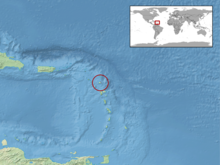Alsophis antiguae
| Antiguan racer | |
|---|---|
 |
|
| Scientific classification | |
| Kingdom: | Animalia |
| Phylum: | Chordata |
| Class: | Reptilia |
| Order: | Squamata |
| Suborder: | Serpentes |
| Family: | Dipsadidae |
| Genus: | Alsophis |
| Species: | A. antiguae |
| Binomial name | |
|
Alsophis antiguae Parker, 1933 |
|
 |
|
The Antiguan racer (Alsophis antiguae) is a harmless rear-fanged (opisthoglyphous) grey-brown snake that was until recently found only on Great Bird Island off the coast of Antigua, in the Eastern Caribbean. It is among the rarest snakes in the world. However, in the last 20 years, conservation efforts have boosted numbers from an estimated 50 to over 1,100 individuals by eradicating non-native predators and reintroducing the snake to other Antiguan islands in its original range. In addition to Great Bird Island, the Antiguan racer has successfully recolonised the nearby Rabbit Island, Green Island and York Island.
The Antiguan racer is a snake which belongs to the family Dipsadidae, which includes about half of the world's known snake species. It belongs to the genus Alsophis, which contains several species of West Indian racers. Many West Indian racers are threatened or extinct.
This racer exhibits sexual dimorphism. The adult racer is typically about one meter long, with females being larger than the males. Young adult males are usually dark brown with light creamy markings, while young females are silvery-gray with pale brown patches and markings. Females also have larger heads than the males. However, older individuals of both sexes can be highly variable in colour hue and pattern, and are frequently heavily speckled or blotched in a range of hues, including white, taupe, reddish brown, brown and black.
The Antiguan racer originally inhabited Antigua and Barbuda and probably all of the islands on the Antigua Bank. By 1995, the species was found only on Great Bird Island, a small island 2.5 kilometres off of the northeast coast of Antigua. The island is extremely small at only 8.4 hectares. It prefers to live in shady woodlands with dense undergrowth, although it is also found on sandy beaches and rocky outcrops.
The Antiguan racer is harmless to humans and has a gentle temperament. It is diurnal, being active from dawn to dusk. At night, it rests in a hidden shelter. The Antiguan racer appears to have poor resistance to common snake mites, which are not naturally found in Antigua, which has ended some attempts at captive breeding.
...
Wikipedia

